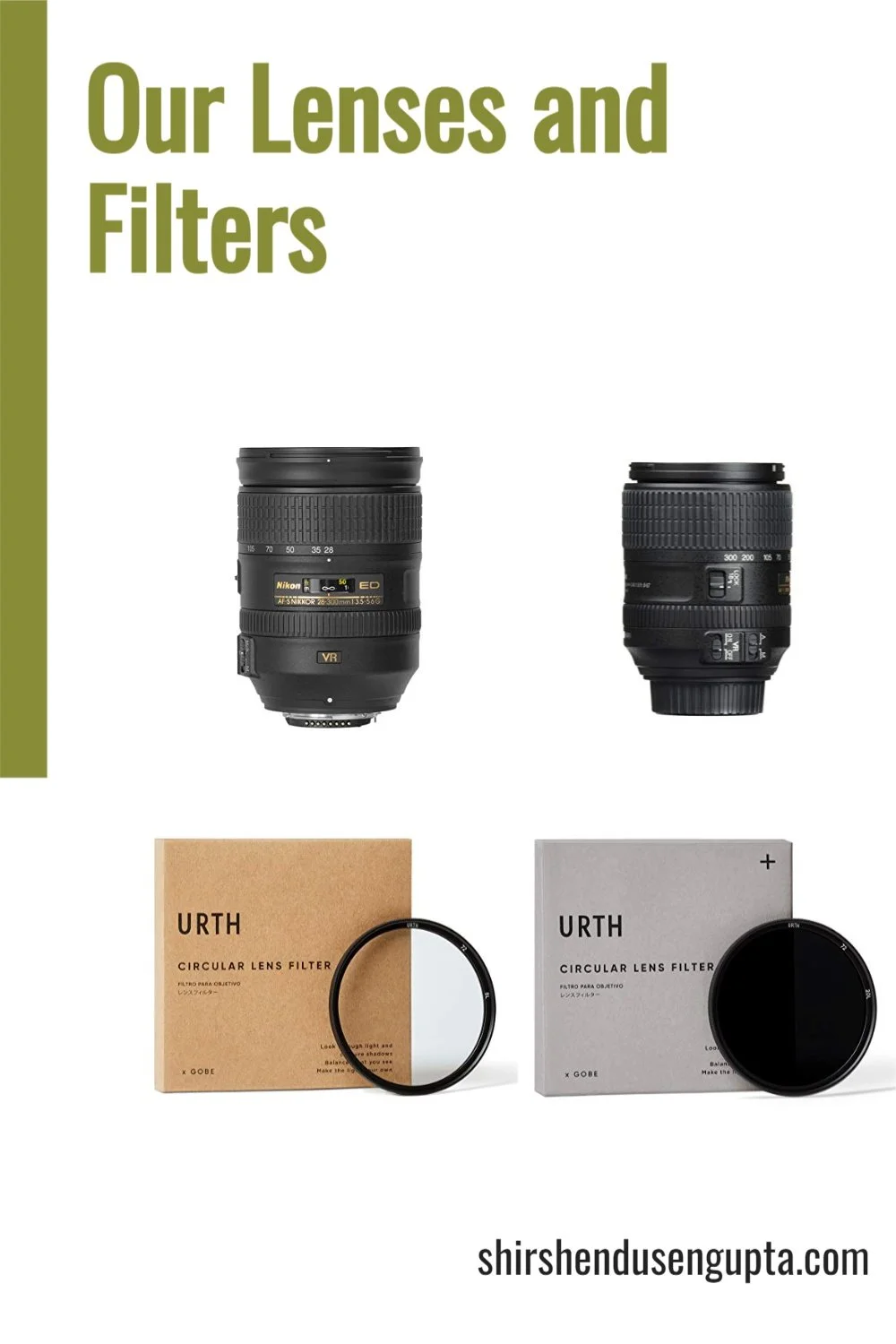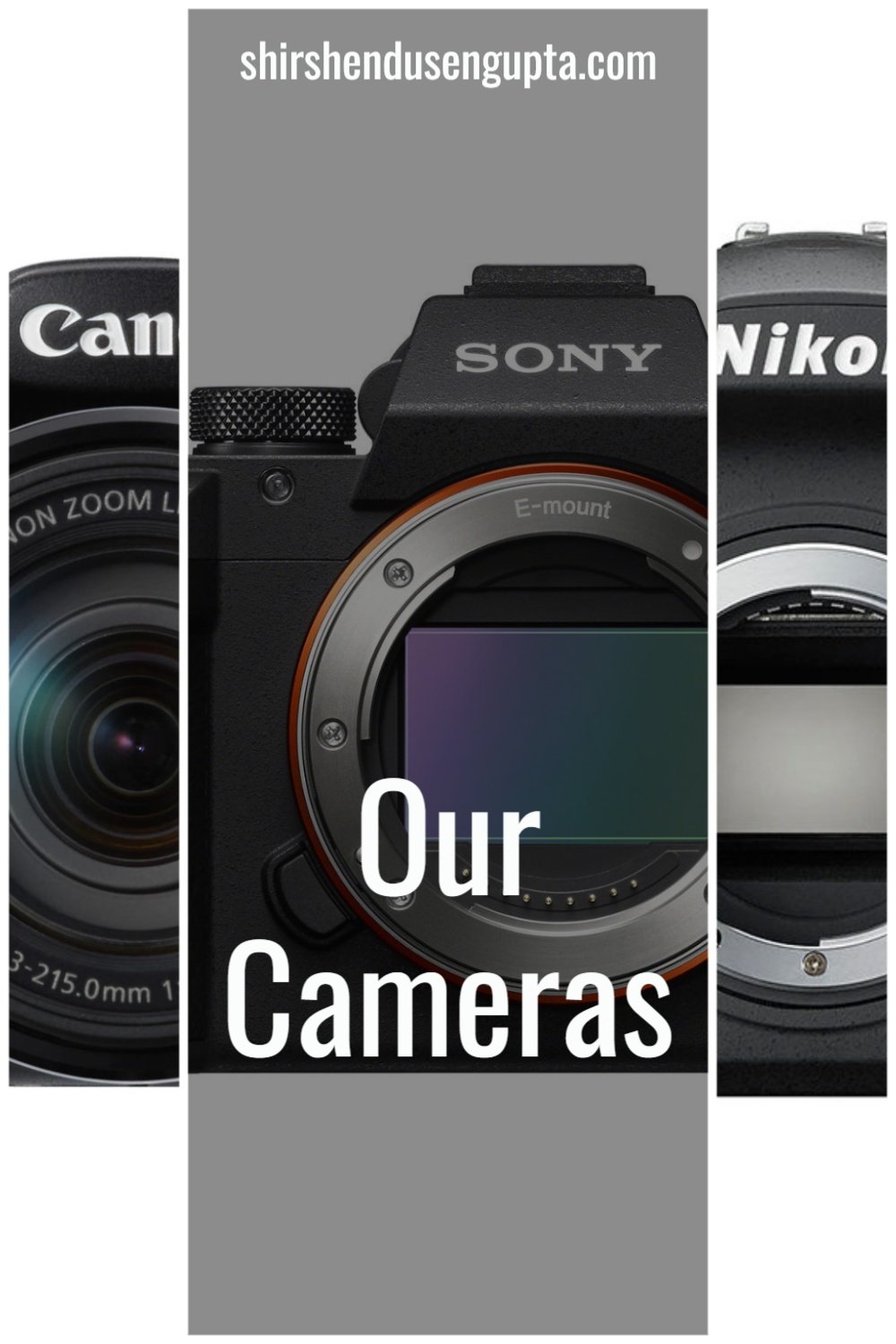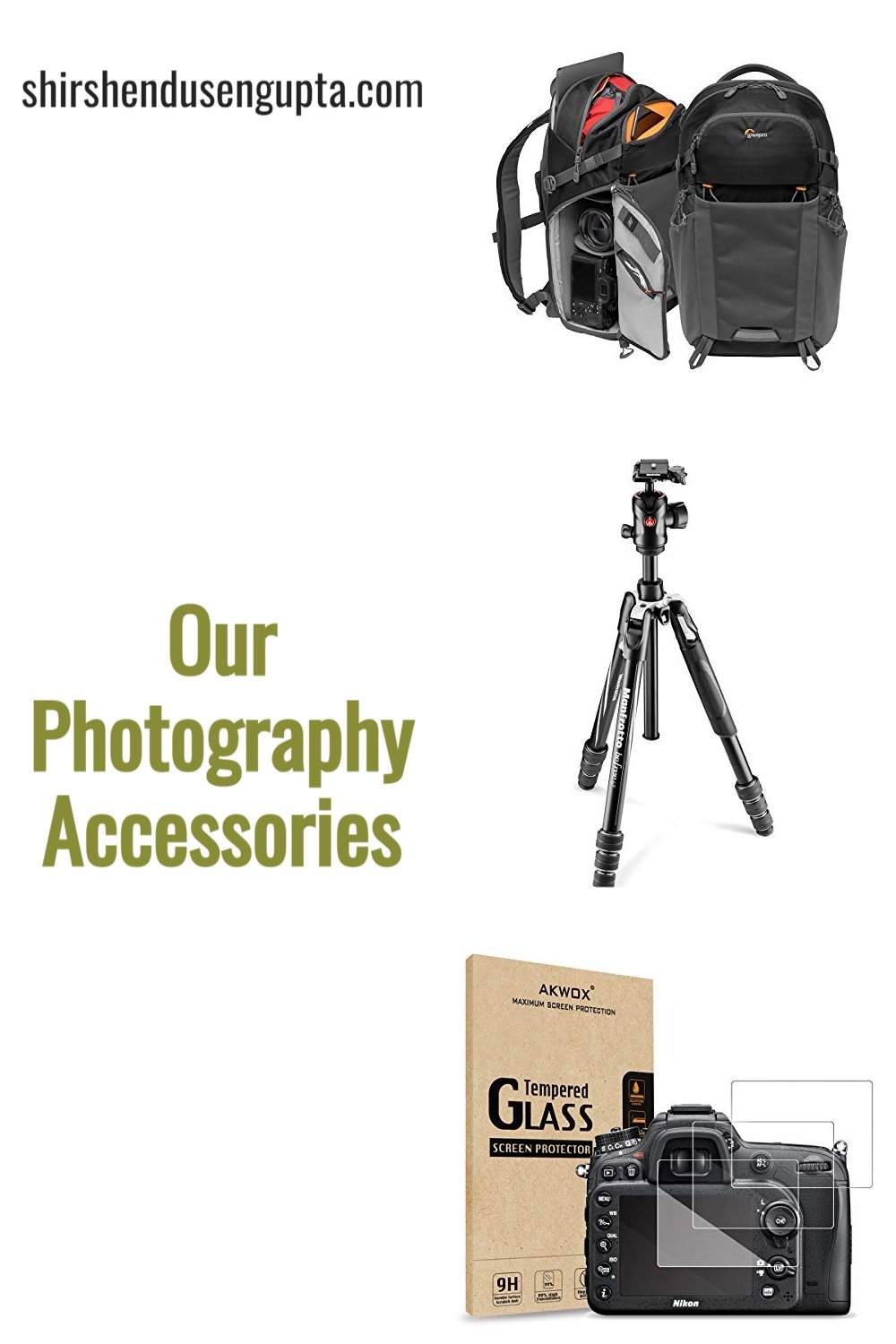Our Lenses and Filters
“Lenses are precious gifts; they are the eyes of the camera!”
Among all the components in a camera system, I think the two most important components that directly impact image quality are the lens and sensor. The rest of the features in the camera body are just facilitators that help us capture the image appropriately but don’t directly affect the quality of the captured image. And to be honest, in this era, there are so many camera bodies from so many different manufacturers being sold in the market with different sensor qualities, features, and ergonomics, but camera bodies within the same sensor category roughly perform the same, with some subtle differences here and there. It is the glass that makes the most significant difference in the image quality. And that’s why it’s crucial to choose the right lens for your camera or style of photography. But before we start, if you are unclear of the differences between the various categories of lenses available in the market, viz. zoom, prime, wide-angle, standard, telephoto, or superzooms, and what are the factors to consider while buying a lens for your camera, please read our article Step-By-Step Beginner’s Guide for Buying Camera Lens | How to Choose the Right Lens for Your Camera?
Now, as I mentioned in the article above, I have always been a patron of superzooms, going against the entire photographer fraternity. Superzooms are a special variety of lenses that range from 24 mm to 600 mm (please note that these focal lengths are 35 mm or full-frame sensor equivalents and need to be divided by a crop factor of 1.5 to convert them to APS-C or half-frame sensor equivalents), covering from wide-angle to telephoto ranges. Superzoom lenses have multiple glass components inside, which leads to a minute loss of light at each component resulting in a slight lack of sharpness (softening) of the image compared to fixed focal length lenses (prime lenses). Also, owing to their wide focal length coverage, they may exhibit some amount of barrel distortions at the long end (wider angles). But these distortions can be easily corrected in post-processing in Lightroom or Adobe Camera RAW by applying sharpening or appropriate lens profiles. This allows a photographer to focus on taking the shot (especially while traveling) rather than continuously changing lenses and missing the moment, making photography fun instead of tiring. Because I travel a lot and with my wife and my kid, changing lenses can be a hassle at times. And that's where superzooms steal the show. My most sold, licensed, and published images in international magazines, newspapers, and journals are all shot by superzooms. In fact, some of them were also shot by superzooms on half-frame sensor cameras. To know how to correct lens distortions in post-processing in Lightroom or Adobe Camera RAW, please read our article My Step-By-Step Photo Post-Processing Workflow | A Beginner’s Guide to RAW Photo Editing | Adobe Lightroom, Photoshop, and Nik Collection Tutorial.
Speaking of filters, filters are coupled with lenses for several reasons. An Ultraviolet (UV) Filter is used to reduce the glare in the image by stopping the ultraviolet rays of the sun, and to offer protection to the lens in general, a Circular Polarizer Filter (CPL) is used to polarize the image (saturate the colors by reducing reflection and atmospheric haze) and a Neutral Density (ND) Filter is used to reduce the amount of light entering the camera to achieve lower shutter speeds. To know more about Neutral Density Filters or Long Exposure Photography in general, please read our article A Step-by-Step Beginner’s Guide to Master Long Exposure Photography | Long Exposure Photography Tutorial | 30 Ultimate Tips and Tricks for Long Exposure Photography.
So, based on your requests, today I'm going to share my perspective on the superzoom lenses and the corresponding filters we've been using over the past years and which one to choose in what scenario. I hope it helps you in making your choice!
Note: The focal lengths for full-frame sensor lenses mentioned below are 35 mm or full-frame sensor equivalents and need to be divided by a crop factor of 1.5 to convert them to APS-C or half-frame sensor equivalents. Similarly, the focal lengths for half-frame sensor lenses mentioned below are APS-C or half-frame sensor equivalents and need to be multiplied with a crop factor of 1.5 to convert them to 35 mm or full-frame sensor equivalents.
This page may contain affiliate links. If you make a purchase through one of them, we may earn a small commission at no additional cost to you. Your support helps us bring you genuine experience-based recommendations on photography, travel, and blogging.
Tamron 25-200mm F/2.8‑5.6 Di III VXD G2
Best Third-Party Superzoom for Sony Full-Frame Mirrorless Cameras
The Tamron 25-200mm F/2.8‑5.6 G2 is a versatile all-in-one zoom for Sony full-frame mirrorless cameras, covering 25 mm wide-angle to 200 mm telephoto. Its VXD linear-motor autofocus delivers fast, quiet, and precise focusing, ideal for people, wildlife, and action. With a short minimum focus distance of 0.16 m and 1:1.9 magnification, it offers half-macro capability for close-ups. Advanced optical design with BBAR-G2 coatings ensures sharp, high-contrast images and pleasing bokeh. Compact (≈ 121.5 mm) and lightweight (≈ 575 g), this lens is dust- and moisture-resistant, making it a practical, high-quality superzoom for travel, landscapes, portraits, and everyday photography.
Sony FE 24-240 mm F3.5-6.3 OSS
Best Sony manufactured Superzoom for Sony Full-Frame Mirrorless Cameras
The Sony FE 24-240 mm F3.5-6.3 OSS is one of the most versatile superzooms we’ve ever used with the ability to go from true wide-angle (24 mm) to telephoto ranges (240 mm) providing a zoom ratio of 10x. You can use this lens for a wide variety of shooting situations while on the go, without having to switch lenses. The autofocus motor is quick and smooth. Handheld telephoto and low-light shooting are made easier by built-in OSS (Optical SteadyShot) image stabilization. Its advanced optical design minimizes distortions and maintains optimal image quality throughout the range. The design is dust and moisture-resistant for reliable operation in difficult conditions.
AF-S FX Nikkor 28-300 mm F3.5-5.6G VR
Best Superzoom for Nikon Full-Frame DSLR Cameras
With an impressive 10.7x zoom capability, the AF-S Nikkor 28-300 mm F3.5-5.6G ED VR is the world's largest-ever zoom ratio lens made for full-frame sensor cameras. It covers a wide range of focal lengths right from wide-angle to telephoto while maintaining an f/5.6 aperture at the telephoto end. On top of that, Nikon's second-generation Vibration Reduction System delivers sharp results even at handheld telephoto shooting. Most of our images shot with Nikon D750 are taken with this lens. So I wholeheartedly recommend this lens travel and all-round photography.
AF-S DX Nikkor 18-300 mm F3.5-6.3G VR
Best Nikon manufactured Superzoom for Nikon Half-Frame DSLR cameras
The AF-S DX Nikkor 18-300 mm F3.5-6.3G ED VR is a powerful DX-format lens with 16.7x zoom and super-telephoto reach. With a wide focal range of 18-300 mm, this compact, highly portable lens is ideal for travel, sports, and wildlife photography as the body design is remarkably compact without compromising image quality. ED glass and aspherical lens elements ensure high resolution and contrast. Nikon's Vibration Reduction System delivers clear images, even when shooting handheld at the super-telephoto lens. Coupled with Nikon D7200, this lens has been our companion for innumerable trips. So if you are looking for a half-frame superzoom, don’t think twice!
AF-S DX Nikkor 18-200 mm F3.5-5.6G VR
Affordable Nikon manufactured Superzoom for Nikon Half-Frame DSLR cameras
If you do not need a zoom range of 300 mm or have a tighter budget, then you can go for the AF-S DX Nikkor 18-200 mm F3.5-5.6G ED VR lens instead of the 18-300 mm one. Equipped with Nikon's Vibration Reduction System and exclusive Silent Wave Motor (SWM), this popular all-round lens delivers stable images with fast, quiet autofocus and great low-light performance at an 11.1x zoom ratio. This was our first ever superzoom and we strongly recommend it if 200 mm zoom suffices your needs.
Tamron AF 18-400 mm F3.5-6.3 DI-II VC HLD for Nikon DX Cameras
Best Third-Party Superzoom (Ultra-Tele-Megazoom) for Nikon Half-Frame DSLR cameras
Tamron has been releasing impressive superzooms at affordable prices for years now. With a stupendous 22.2x zoom capability, the Tamron 18-400mm F/3.5-6.3 DI-II VC HLD is the world's largest-ever zoom ratio lens made for half-frame sensor cameras. In addition, this lens offers exceptional optical performance across the entire zoom range – from wide-angle to ultra-telephoto. With its moisture-resistant construction, Tamron combines the art of photography with the joy of travel. You can shoot breathtaking landscapes and neon-lit cities to detailed portraits, colorful birds and tiny flowers, all with this one lens. Before switching to full-frame sensor cameras, this was the lens we used most with our Nikon D7200 half-frame sensor camera and the results were spectacular. So we recommend this lens hands down to all our readers.
Tamron AF 16-300 mm F3.5-6.3 DI-II VC for Nikon DX Cameras
Best Third-Party Wide-Angle Superzoom for Nikon Half-Frame DSLR cameras
The Tamron AF 16-300 mm F3.5-6.3 DI-II VC is a highly versatile mega-zoom lens that covers a huge focal length range from 16 mm to 300 mm. At 16 mm, it allows true wide-angle views with minimal distortion. All my images of the Norwegian fjords are shot with this lens. So for you, if wide-angle is a necessity for shooting landscapes while on the go, I cannot recommend this lens enough!
UV (Ultraviolet), ND 64 (6 Stop) and ND 1000 (10 Stop) Neutral Density (ND) Filters with 72 mm Diameter
Fits Sony FE 24-240 mm, AF-S DX Nikkor 18-200 mm and Tamron AF 18-400 mm Lenses
For every superzoom lens that I have, I always have a set of 3 filters. A UV (Ultraviolet) filter to reduce the glare in the image and offer protection to the lens, a 6 stop ND filter for long exposure photography of waterfalls (to get subtle silkiness in the water) or during low light conditions like before sunrise or after sunsets when the sky’s already quite dark and a 10 stop ND filter for daytime long exposures when the sky is bright. To know more about Neutral Density (ND) filters or long-exposure photography at large, please read our article A Step-by-Step Beginner’s Guide to Master Long Exposure Photography | Long Exposure Photography Tutorial | 30 Ultimate Tips and Tricks for Long Exposure Photography. Based on my personal experience, I recommend the following UV, 6 stop ND, and 10 stop ND filters with 72 mm diameter that fits the Sony FE 24-240 mm, AF-S DX Nikkor 18-200 mm, and Tamron AF 18-400 mm lenses that I recommended above. I’m sure you will absolutely love them!
UV (Ultraviolet), ND 64 (6 Stop) and ND 1000 (10 Stop) Neutral Density (ND) Filters with 77 mm Diameter
Fits AF-S FX Nikkor 28-300 mm Lens
Based on my personal experience, I recommend the following UV, 6 stop ND, and 10 stop ND filters with 77 mm diameter that fits the AF-S FX Nikkor 28-300 mm lens that I recommended above. I’m sure you will absolutely love them!
UV (Ultraviolet), ND 64 (6 Stop) and ND 1000 (10 Stop) Neutral Density (ND) Filters with 67 mm Diameter
Fits Tamron 25-200mm, AF-S DX Nikkor 18-300 mm, and Tamron AF 16-300 mm Lenses
Based on my personal experience, I recommend the following UV, 6 stop ND, and 10 stop ND filters with 67 mm diameter that fits the Tamron 25-200mm, AF-S DX Nikkor 18-300 mm, and Tamron AF 16-300 mm lenses that I recommended above. I’m sure you will absolutely love them!
Epilogue
So that was the list of all the lenses that we are currently using or have previously used that we recommend to you based on our personal experience. Additionally, I would also advise you to read our article Step-By-Step Beginner’s Guide for Buying Camera Lens | How to Choose the Right Lens for Your Camera? to understand the differences between the various categories of lenses available in the market, viz. zoom, prime, wide-angle, standard, telephoto, or superzooms and what are the factors to consider while buying a lens for your camera. Hopefully, then you will be in a better position to make an informed decision.
Please let us know in the comments below if our articles have helped you in making your decision. Until then, merry traveling and happy shooting!
Pin the article
Bookmark the article for reading later!
Want us to write an article for you?
Articles for magazines, newspapers, and websites!
Watch our Videos
Check out our videos on our Youtube Channel!
Join the Newsletter
Get updates on our latest articles!
We respect your privacy. Read our policy here.
























